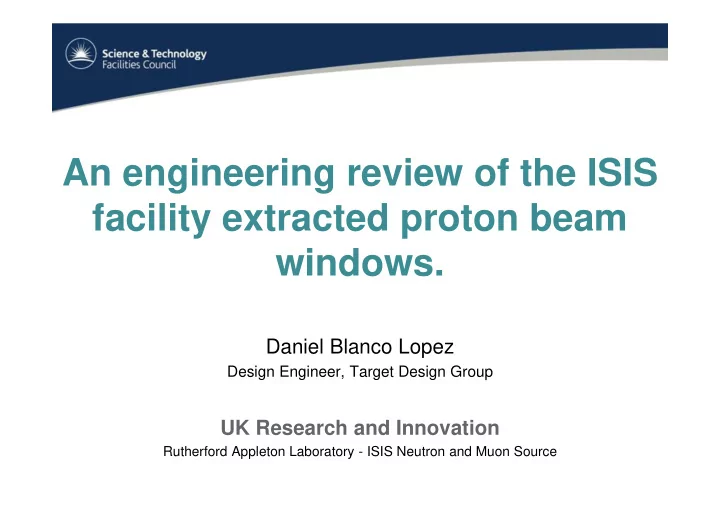

An engineering review of the ISIS facility extracted proton beam windows. Daniel Blanco Lopez Design Engineer, Target Design Group UK Research and Innovation Rutherford Appleton Laboratory - ISIS Neutron and Muon Source
Agenda • Introduction to ISIS • TS1 Proton Beam Window (PBW) – EPB1 – TS1 Interface – Configuration – Monitoring • TS2 Proton Beam Window (PBW) – EPB2 – TS2 Interface – Configuration – Monitoring • Window Replacement (TS1 vs TS2) • Summary/Comparison • Future work
Harwell Science & Innovation Campus Introduction to ISIS Agenda • Introduction to ISIS – TS1 vs TS2 – EPB1 vs EPB2 • TS1 EPB Window – EPB1 – TS1 Interface – Configuration, materials – Cooling system, heat deposition, water flow, etc… – Monitoring and measurements (temps, water flow, etc..) • TS2 EPB Window – Same bulletpoints as TS1???? • Windows Replacement (TS1 vs TS2) • TS2 EPBW Failure • Future work/further investigation
ISIS Facility
TS2 High Energy Protons TS1
TS1 SYNCHROTRON EPB2 TS2
ISIS First Target Station (TS1) • In operation since Dec 1984 • Target – 12 tungsten plates clad in tantalum Typically 160 µ A of 800 MeV protons • Maximum power density ~400 MW/m 3 • Peak energy per pulse ~11 MJ/m 3 /pulse • • 4 out of 5 pulses (50Hz) • Beam sigma of ~17mm (overall beam spot diameter ~70mm)
ISIS Second Target Station (TS2) • In operation since 2008 • Target - tungsten cylinder clad in tantalum Typically 40 µ A of 800 MeV protons • Maximum power density ~700MW/m 3 • Peak energy per pulse ~70MJ/m 3 /pulse. • • 10 Hz (1 out of every 5 pulses) • Beam sigma of ~6mm (overall beam spot diameter ~36mm)
TS1 Proton Beam Window (PBW) • Double window with water flowing between. • Ø 145 mm, 3500 mm long • Each window ~3mm thick Inconel 718. • Windows welded to austenitic stainless steel support tubes. • Beam heat input ~ 2500W . • Water cooled, 26 litres/min. • First one operated for ~25 years, replaced in 2010.
EPB1 – TS1 Interface • Passes thought the monolith shielding and target void vessel. • 546 mm from the Target face • Flange built into the shielding wall (EPB tunnel)
TS1 PBW Configuration FRONT END SECTION BACK END SECTION Outer Inconel 718 Inlet/Outlet Inner Inconel 718
TS1 PBW Monitoring 26 l/min Demin Water • Flow • Temp
TS2 Proton Beam Window (PBW) • 0.5mm thick 5083-O aluminium alloy window • Ø57 mm, 630 mm (nose section) • Friction welded joint to austenitic stainless steel support tube. • Beam heating 10W total. • Passive cooling by void vessel helium atmosphere. • Operating since 2008, failure 2017
EPB2-TS2 Interface • Passes thought the monolith shielding and target void vessel. • 384 mm from the Target face • Attached to the EPB line by a remote clamp Remote Clamp EPB 384 Target Window Protons TRAM EPB VOID VESSEL
TS2 PBW Assembly
TS2 PBW Monitoring Halo Monitor Profile Monitor Collimator (thermocouples)
TS1 PBW Replacement • 6 month shutdown • High dose • Mobile specialist tooling
TS2 PBW Failure and Replacement (Dan Coates talk) • 2 month shutdown Tube Clamp • In cell, no rad dose Lifting Point X – Y Adjustment Caster Wheels
Summary TS1 PBW TS2 PBW • Material • Material – Inconel 718 – Al Alloy 5083 • Thickness • Thickness – 2 Plates 3 mm thick, separated by 1.5 – 0.5 mm mm water channel • 160 µA • 40 µA • Heat deposition • Heat deposition – 2500 W – 10 W • Cooling • Cooling – Water Cooling, 26 l/min – Passive cooling, helium • Distance to the target • Distance to the target – 546 mm – 383 mm • Replacement • Replacement – 6 month shutdown – 2 month shutdown – High rad levels (7.8 Sv/h on contact) – In cell • Estimated Life Span • Estimated Life Span – 25+ years – 6 years*
Future Work • Remove the PBW from the Hot Cell • Test Sample cycle loading • Improve life assessment procedures • Better understanding of radiation damage and embrittlement mechanisms in PBW • Post Irradiation Examination
Thank you – Questions?
Recommend
More recommend